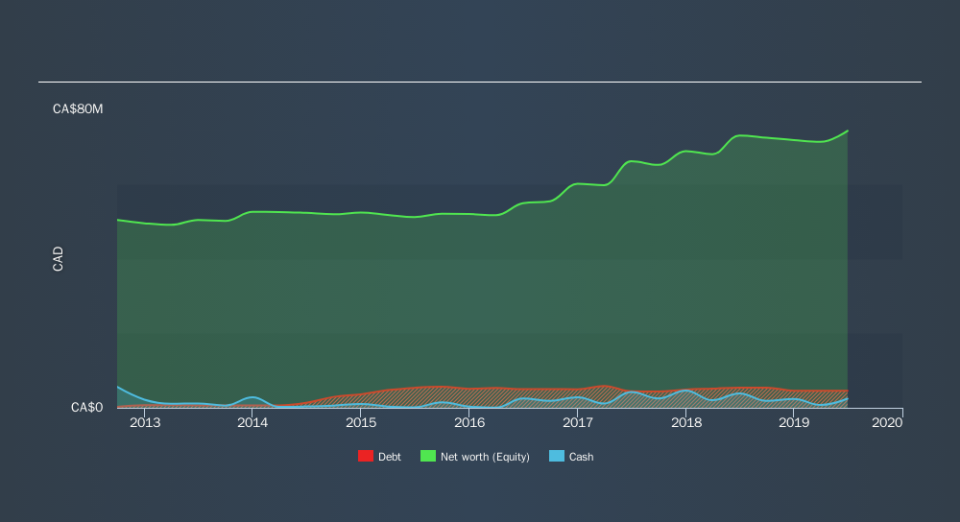Does Treasury Metals (TSE:TML) Have A Healthy Balance Sheet?

Howard Marks put it nicely when he said that, rather than worrying about share price volatility, 'The possibility of permanent loss is the risk I worry about... and every practical investor I know worries about.' So it might be obvious that you need to consider debt, when you think about how risky any given stock is, because too much debt can sink a company. We can see that Treasury Metals Inc. (TSE:TML) does use debt in its business. But is this debt a concern to shareholders?
When Is Debt Dangerous?
Generally speaking, debt only becomes a real problem when a company can't easily pay it off, either by raising capital or with its own cash flow. Ultimately, if the company can't fulfill its legal obligations to repay debt, shareholders could walk away with nothing. However, a more common (but still painful) scenario is that it has to raise new equity capital at a low price, thus permanently diluting shareholders. Of course, the upside of debt is that it often represents cheap capital, especially when it replaces dilution in a company with the ability to reinvest at high rates of return. When we think about a company's use of debt, we first look at cash and debt together.
See our latest analysis for Treasury Metals
What Is Treasury Metals's Debt?
The image below, which you can click on for greater detail, shows that Treasury Metals had debt of CA$4.57m at the end of June 2019, a reduction from CA$5.38m over a year. However, it also had CA$2.44m in cash, and so its net debt is CA$2.13m.
How Strong Is Treasury Metals's Balance Sheet?
According to the last reported balance sheet, Treasury Metals had liabilities of CA$3.04m due within 12 months, and liabilities of CA$6.17m due beyond 12 months. Offsetting this, it had CA$2.44m in cash and CA$237.3k in receivables that were due within 12 months. So it has liabilities totalling CA$6.53m more than its cash and near-term receivables, combined.
Of course, Treasury Metals has a market capitalization of CA$55.8m, so these liabilities are probably manageable. But there are sufficient liabilities that we would certainly recommend shareholders continue to monitor the balance sheet, going forward. The balance sheet is clearly the area to focus on when you are analysing debt. But it is future earnings, more than anything, that will determine Treasury Metals's ability to maintain a healthy balance sheet going forward. So if you're focused on the future you can check out this free report showing analyst profit forecasts.
Given its lack of meaningful operating revenue, investors are probably hoping that Treasury Metals finds some valuable resources, before it runs out of money.
Caveat Emptor
Over the last twelve months Treasury Metals produced an earnings before interest and tax (EBIT) loss. To be specific the EBIT loss came in at CA$2.0m. Considering that alongside the liabilities mentioned above does not give us much confidence that company should be using so much debt. Quite frankly we think the balance sheet is far from match-fit, although it could be improved with time. Another cause for caution is that is bled CA$6.6m in negative free cash flow over the last twelve months. So suffice it to say we consider the stock very risky. When I consider a company to be a bit risky, I think it is responsible to check out whether insiders have been reporting any share sales. Luckily, you can click here ito see our graphic depicting Treasury Metals insider transactions.
If you're interested in investing in businesses that can grow profits without the burden of debt, then check out this free list of growing businesses that have net cash on the balance sheet.
We aim to bring you long-term focused research analysis driven by fundamental data. Note that our analysis may not factor in the latest price-sensitive company announcements or qualitative material.
If you spot an error that warrants correction, please contact the editor at editorial-team@simplywallst.com. This article by Simply Wall St is general in nature. It does not constitute a recommendation to buy or sell any stock, and does not take account of your objectives, or your financial situation. Simply Wall St has no position in the stocks mentioned. Thank you for reading.

 Yahoo Finance
Yahoo Finance 
